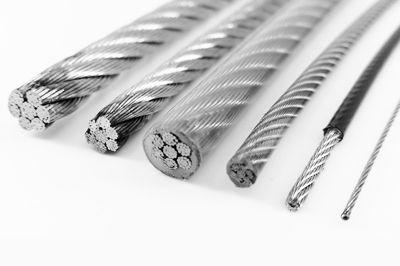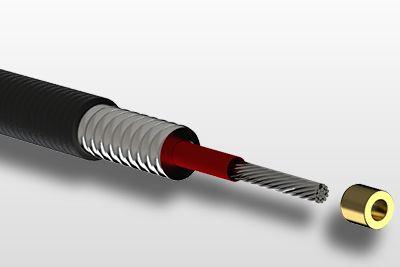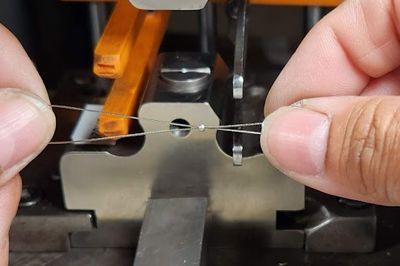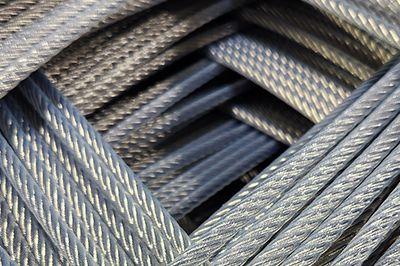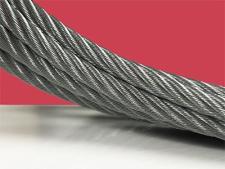The cost to purchase wire rope fluctuates considerably, depending upon an extensive range of variables. Familiarizing oneself with what exactly informs wire rope price equips cable buyers with the right cable material, diameter, and construction the first time, every time. On the other hand, being unaware of what goes into the pricing of cable oftentimes means wasted spending, discarded cable, cable assemblies, and later, perhaps even worse, delays taking a new product to market.
But because what influences wire rope costs is extensive, it’s critical to unpack a few of the most weighted variables affecting cost in order to arrive at estimated cable costs.
Wire Rope Construction: Factors Affecting Flexibility
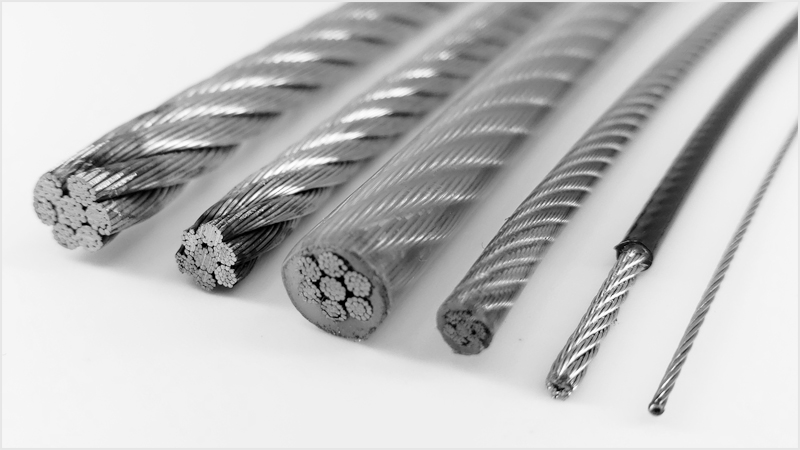

Among the most critical factors impacting the cost of wire rope is the cable’s wire configuration, which is known as “cable construction.”
Wire rope is stranded in a helical geometry, making, for instance, a 1x7 cable construction a cable comprising a single, center core wire, wrapped helically by six additional wires. Hence the seven wires found in a single 1x7 cable. In cables consisting of more wires, such as a 7x7 cable - a 49-wire construction - the cable begins with a single 1x7 construction acting as the core, which is then wrapped in a secondary stranding operation by an additional six 1x7 cables. Combined, the six 1x7 cables, stranded helically, produce a 7x7 cable construction.
But, while the sheer quantity of wires will certainly drive-up material usage and thus material costs, cable wire count is often a function of adding to the cable’s flexibility, while meeting a factor of safety identified by the application’s requirements. Therefore, how flexible the total wire count makes the cable will impact cable cost, not only because of an increase in raw materials consumption, but also due to the sophisticated manufacturing processes that go into achieving the flexibility being sought. In simplest terms, the more wires added to a cable’s construction, the more flexibility the cable will yield, and thus, the higher the Wire rope price.
Conversely, cable constructions involving only a few wires will produce a more rigid cable behavior, and accordingly, take less time to manufacturer and of course, require less raw material. If a .006”, 1x7 stainless steel cable, a relatively flexible 1x7 variety, meets both the required factor of safety, as well as the application’s flexibility conditions, a cost savings can be realized, if compared with larger wire counts that achieve the same strength and flexibility characteristics.
In general, knowing the degree of flexibility a wire rope must meet is critical to ensuring a motion control system performs without failure, which is why knowing how flexible the cable needs to be is among the critical first steps in determining cable cost. The more wires needed to achieve the required strength and flexibility, means more raw material, more complex stranding operations, and ultimately, higher cable costs.
Swaging Processes for Improved Flexibility and Wear Resistance
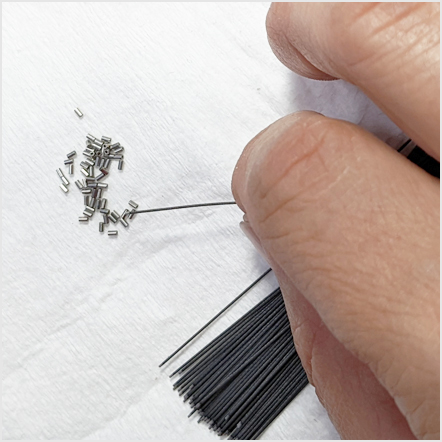

Swaging wire rope is the act of feeding completed cable through a series of hammers and swaging dies to change the mathematical characteristics the stranding operation produced. Like a medieval blacksmith might pound steel into the shape of a sword, the cable is pulled through the path of the swaging hammers, which apply force to the swaging dies. This repeated hammering operation is undertaken until the desired cable geometry and measurements have been achieved.
Among the many benefits of swaging cable is that, for one, it can reduce the diameter of the cable. This is incredibly critical when the stranding operation does not meet the tight tolerances required of the cable. Previously unachievable at the stranding operation level, in this use case scenario, swaging the cable accomplishes a smaller diameter by virtue of the repeated striking of the cable during the hammering process.
Secondly, along with reducing cable diameter, swaging also helps the cable achieve a smooth, tighter wire configuration. The added slickness produced through the swaging process reduces the potential for wear and friction to cause premature or unplanned cable failure, or worse, motion system failure.
Lastly, swaging cable is also strongly correlated with an increase in tensile strength because the forces of the hammers and swaging dies, also known as tooling, compress the cable’s individual wires together, forcing them to conform to the cavity of the swaging dies, which ultimately work-hardens the cable.
Wire Rope Material Considerations
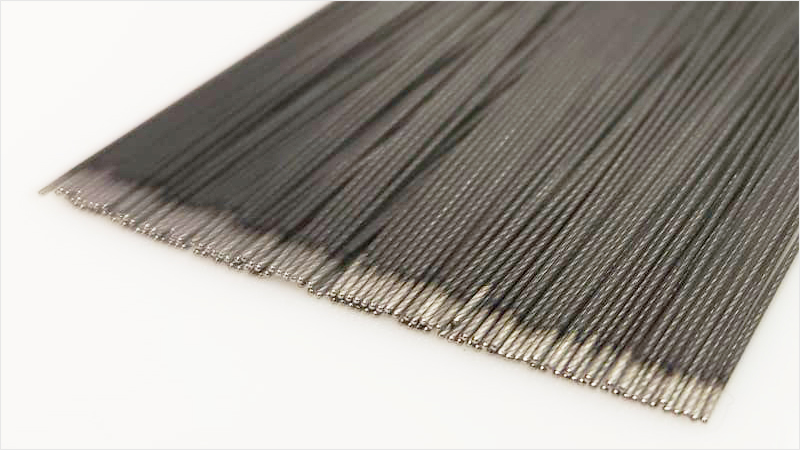

Also, among the more likely factors that influence the cost of wire rope is the cable’s material.
Wire rope can be made from galvanized steel, stainless steel, tungsten, or for that matter, even more, exotic alloys like platinum, nitinol, and a host of others.
Stainless Steel Cable
Thanks to a minimum of 10.5% of chromium contained in stainless steel cable, this cable material delivers excellent corrosion resistance because the presence of chromium creates a layer of protection against corrosive artifact and particulate, such as water, dirt and humidity. Stainless steel cable is therefore an ideal cable material where harsh, damp environments are found. But, as suited as stainless steel cable is to many motion control applications, there are certain trade-offs. Stainless steel cable, for instance, contains nickel, which over time softens the steel, eventually exposing the stainless steel cable to wear as it makes repeated contact with mating components.
In all, stainless steel cable is a popular and effective cable material for a myriad of different applications. But this material’s strength and resistance to corrosion drives cost too, making stainless steel a more expensive cable material than galvanized steel, for example.
Galvanized Steel Cable
Galvanized steel is easier to manufacture, requiring fewer manufacturing steps than producing stainless steel. Galvanized steel cable is subsequently less expensive to purchase as well.
Furthermore, stainless steel’s strength lands at approximately 621 MPa, while galvanized steel maxes out at around 550 MPa. Providing the cable application’s tensile requirements fall within the rated strength of the galvanized steel cable, this cable material is among the most cost-effective options available.
Adding to galvanized steel’s benefits is that it is treated with a zinc coating. The zinc contained in galvanized steel cable supplies a strong layer of corrosion resistance, similar to stainless steel cable. And though the chromium content of stainless steel cable also provides similar corrosion resistance benefit, the zinc content of galvanized steel cable will eventually breakdown, making it more vulnerable in marine environments than its chromium-infused, stainless steel counterpart.
Tungsten Cable
Tungsten cable is a superior mechanical cable material when competing with stainless steel and galvanized steel cable choices.
For instance, the melting point of stainless steel cable is between 2,550° and 2,790° Fahrenheit, whereas the melting point of the zinc contained in galvanized steel cable is around 900° Fahrenheit. Once the zinc has melted away from the steel itself, the galvanization has been removed from the cable.
If the cable application calls for the cable to tolerate temperatures greater than those these two popular cable materials can endure, tungsten cable is a more expensive, but ideal choice.
Tungsten cable, which is burgeoning right now among surgical robotics motion control systems, possesses more flexibility, more strength (in comparable wire counts and cable diameters), and hold a higher tolerance to extreme heat than any other metal on earth.
Though not the only reason, tungsten cable’s strength superiority alone leads to its popularity with the makers of surgical robots. For instance, tungsten achieves a tensile strength of 980 MPa, while, as mentioned, stainless steel achieves as much as 621 MPa. Tungsten cable’s flexibility is also impressive when compared against steel cable alternatives. Steel cable, stainless or galvanized, possess a natural elasticity, which forces these cables to bounce or spring back to a linear shape. Tungsten, on the other hand, lays limp in one’s hand, falling at each side like a wet noodle might. The lack of resistance tungsten exhibits when making tight radii, makes it a more friction-resistant cable material when contacting a pulley system or other mating parts.
And while tungsten cable provides superior strength and tolerance to resistance, friction and corrosion, it is exactly these benefits that make it more costly a mechanical cable to produce because, simply put, it’s harder to manipulate.
Cable Coating Options for Greater Performance and Resilience
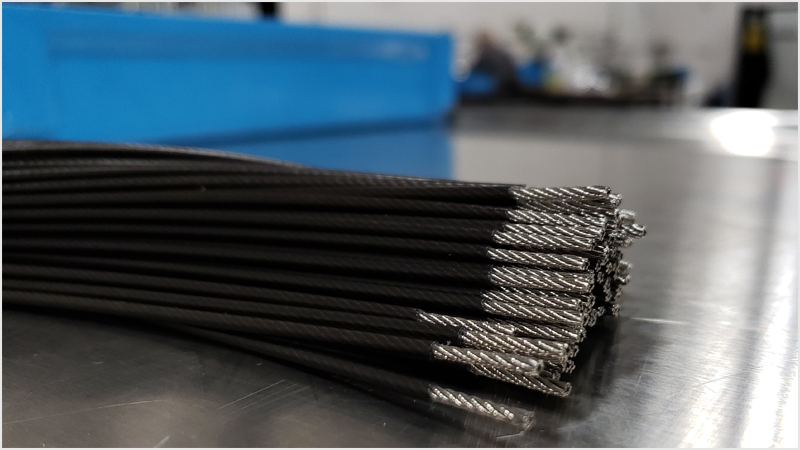

Cost considerations must also be made for applications where coating the wire rope in a protective molten material is required.
Cable coatings are applied to bare wire rope to lend more protection and durability to the cable, which in turn improves performance and the lifespan of the application. Among the most common wire rope coatings are nylon, which is also known as polyimide or PA, vinyl, or what is commonly called PVC, and FEP, which like nylon and vinyl, is better known by its brand name, Teflon®. Polyurethane or PU, as well as PE or Polyethylene coatings are also often used to coat wire rope as well.
These cable coatings deliver protections against wear, but they also help reduce the harmful presence of friction, which improves resistance to fatigue as well. But, with the added protection comes added manufacturing operations, more raw materials, and even additional quality testing to ensure that at each stage of the cable’s development, no single operation phase of production falls outside standards. These variables all contribute to increasing overall cable cost.
Custom Cable Assemblies vs. Bulk Cable
When sourcing wire rope, consider whether the cable can be delivered in bulk, as cut lengths, or as completed assemblies. Bulk cable, for example, can be shipped on a spool, which dramatically reduces the quantity of manufacturing operations required to deliver the completed cable product to the buyer. Bulk cable can be coated or bare in variety too. Cut lengths, however, are a more expensive cable buying proposition because the cable needs to be cut with precision instruments, and its ends professionally terminated to avoid wires from fraying or losing their terminated shape.
Furthermore, when cutting wire rope, the cable’s material determines both the method and ease with which the cable is cut. Take, for instance, the cutting of stainless steel cable into fixed lengths. Mechanical cutters can do such a job effortlessly, and that operation is usually adequate to prevent wire fray. But cutting tungsten cable, which below osmium, is the second densest element in the periodic table, requires the extreme heat that only a plasma cutter can produce. Additionally, the plasma cutting process also involves simultaneously applying a small amount of molten material to the cable end as the cutting takes place, which again, prevents the wires from coming apart at the terminated ends.
Cable assemblies are any cable comprising a fixed length and at least one fitting swaged or pressed to the cable. Simple cable assemblies, such as those with an eyelet on each end, can be bought in small, prototyping quantities, or in substantial product purchase orders. This is also true of more complicated, custom cable assemblies. No matter the level of complexity, custom cable assemblies can be produced to just about any specifications. Speaking broadly, among the remaining additional cable cost factors to consider involve special considerations, such as the need for clean or steril/aeseptic rooms where cables are handled for MedTech applications, as well as the fundanmentals, such as how many need to be produced, how quickly, and how difficult is the cable assembly to produce.
If the wire used to manufacture the custom cable assembly is .00072" for example, this would mean that you are producing mechanical cable using wires smaller than a single human hair. As cable is produced in increasingly miniature diameters, costs will go up due to the challenging nature inherent in handling and manipulating such small diameter wires.
Working with such ultrafine mechanical cable does introduce more engineering, tooling, and supervision, and all therefore contribute to cable cost, as achieving strength and tolerance becomes increasingly difficult to accomplish. For example, if the fittings swaged to a cable are also as small as the cable itself, achieving expected tolerances will require swaging dies with equally infinitesimal cavities, which all equates to more dies, tooling production, engineering, and supervision during production runs.
Collaborate with Your Wire Rope Source
When considering the cost of wire rope, it is essential to keep in mind that the price will depend on at least these factors. Cable size, wire count, strength, tolerance, material type, and additional features like cable coating, and fittings, all coalesce to determine wire rope cost. Be sure you get the right advice early in the development of your wire rope and cable assemblies by asking the engineers at Sava to guide you, step-by-step, through the entire production process.

